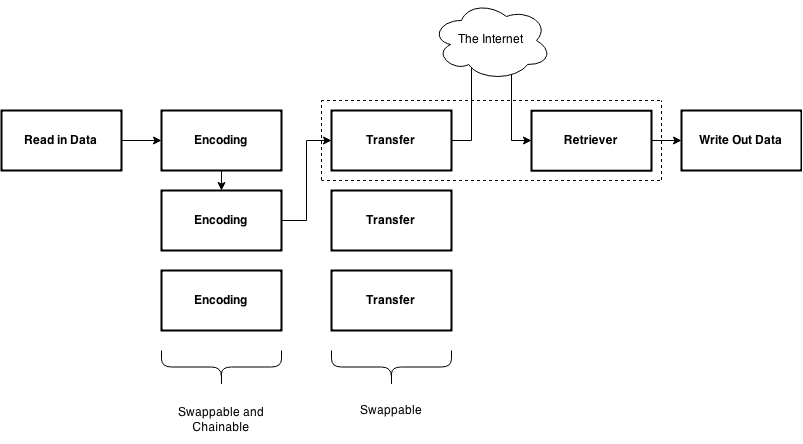Using social media as a tool for data exfiltration.
sneaky-creeper has two base elements: encoders (the left column in the diagram above, they encode/decode data) and channels (the part that actually does Internet things, in the dotted rectangle in the diagram above). You can chain encoders to, say, base64 encode your data, then encrypt it with RSA, but there can only be one channel in each command. -e specifies encoders (specify as many as you want), and -c specifies channels.
To see what channels are available:
./screep channels
To see what encoders are available:
./screep encoders
To write some data to a file in plaintext:
echo "some data" | ./screep send -e identity -c file -p '{"file": {"filename": "test.txt"}}'
See how useful that is?
To read the file back in:
./screep receive -e identity -c file -p '{"file": {"filename": "test.txt"}}'
To do the same, but encrypt the file's contents with RSA:
echo "some data" | ./screep send -e rsa -c file -p '{"file": {"filename": "test.txt"}, "rsa": {"publicKey": "rsakey.pem.pub"}}'
./screep receive -e rsa -c file -p '{"file": {"filename": "test.txt"}, "rsa": {"privateKey": "rsakey.pem"}}' privateKey
To just test out the base64 encoder:
echo "some data" | ./screep echo -e b64
If you specify multiple encoders, the order is automatically reversed on decode so that you can specify them in the same order on both sides of the transmission and everything will work.
Many channels and encoders require parameters to function. These parameters are submitted as JSON, keyed with the encoder or channel name. The value of these parameters is either one or several key-value pairs with the key specified by the encoder or channel.
For example, the rsa encoder requires a public key filename, keyed as publicKey to send data, and a private key filename keyed as privateKey to receive it. Since the echo command both sends and receives, you can include the necessary parameters via the -p or --parameters flag followed by a JSON string (note the single quotes!) in your command as shown:
echo "super secret" | ./screep echo -e rsa -p '{"rsa": {"publicKey": "rsakey.pem.pub", "privateKey": "rsakey.pem"}}'
Alternatively, because it's a bore to enter all those parameters every time, they can be placed in a JSON file (with no need for the single quotes). In that case, simply use the filename as an argument.
For example, if you have a file config.json which contains the JSON:
{"rsa": {"publicKey": "rsakey.pem.pub", "privateKey": "rsakey.pem"}}
Import the parameters from it via:
-p config.json or -p "config.json"
Leading to the much more succint command:
echo "super secret" | ./screep echo -e rsa -p config.json
sudo pip install pycrypto twython soundcloud
#####Twitter:
Instructions are here: http://twython.readthedocs.org/en/latest/usage/starting_out.html
When the instructions are complete, go to the Twitter API page
Examine your access level for Consumer Key and Access Key and be sure they are set to read and write.
- If not set to read and write, change the Consumer Key settings to be read and write
- Revoke the Access Token
- Wait five minutes
- Generate a new access token
It should now mimic the access level of the Consumer Key
#####Tumblr:
Make a Tumblr account and create an app. Then, visit the API console and note down the four strings there; these are your key, secret, token, and token_secret.
#####Soundcloud:
Make a Soundcloud account and register and app. Visit your apps console and note the strings for Client ID and for the Client Secret. These are for the ID and secret, while your username and password are for the username and password.
